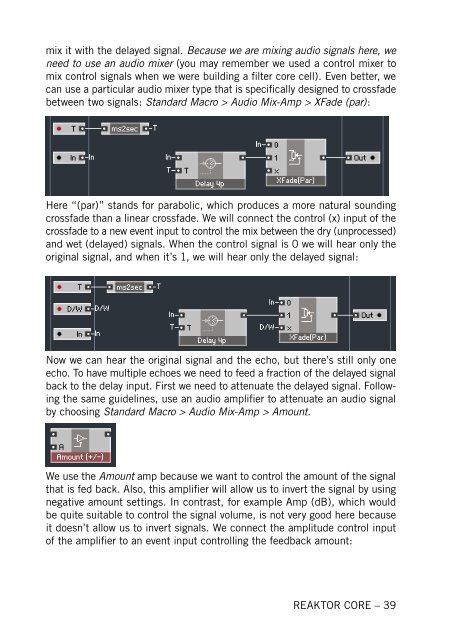1. First steps in Reaktor Core - Native Instruments
1. First steps in Reaktor Core - Native Instruments
1. First steps in Reaktor Core - Native Instruments
Create successful ePaper yourself
Turn your PDF publications into a flip-book with our unique Google optimized e-Paper software.
mix it with the delayed signal. Because we are mix<strong>in</strong>g audio signals here, we<br />
need to use an audio mixer (you may remember we used a control mixer to<br />
mix control signals when we were build<strong>in</strong>g a filter core cell). Even better, we<br />
can use a particular audio mixer type that is specifically designed to crossfade<br />
between two signals: Standard Macro > Audio Mix-Amp > XFade (par):<br />
Here “(par)” stands for parabolic, which produces a more natural sound<strong>in</strong>g<br />
crossfade than a l<strong>in</strong>ear crossfade. We will connect the control (x) <strong>in</strong>put of the<br />
crossfade to a new event <strong>in</strong>put to control the mix between the dry (unprocessed)<br />
and wet (delayed) signals. When the control signal is 0 we will hear only the<br />
orig<strong>in</strong>al signal, and when it’s 1, we will hear only the delayed signal:<br />
Now we can hear the orig<strong>in</strong>al signal and the echo, but there’s still only one<br />
echo. To have multiple echoes we need to feed a fraction of the delayed signal<br />
back to the delay <strong>in</strong>put. <strong>First</strong> we need to attenuate the delayed signal. Follow<strong>in</strong>g<br />
the same guidel<strong>in</strong>es, use an audio amplifier to attenuate an audio signal<br />
by choos<strong>in</strong>g Standard Macro > Audio Mix-Amp > Amount.<br />
We use the Amount amp because we want to control the amount of the signal<br />
that is fed back. Also, this amplifier will allow us to <strong>in</strong>vert the signal by us<strong>in</strong>g<br />
negative amount sett<strong>in</strong>gs. In contrast, for example Amp (dB), which would<br />
be quite suitable to control the signal volume, is not very good here because<br />
it doesn’t allow us to <strong>in</strong>vert signals. We connect the amplitude control <strong>in</strong>put<br />
of the amplifier to an event <strong>in</strong>put controll<strong>in</strong>g the feedback amount:<br />
REAKTOR CORE – 39










